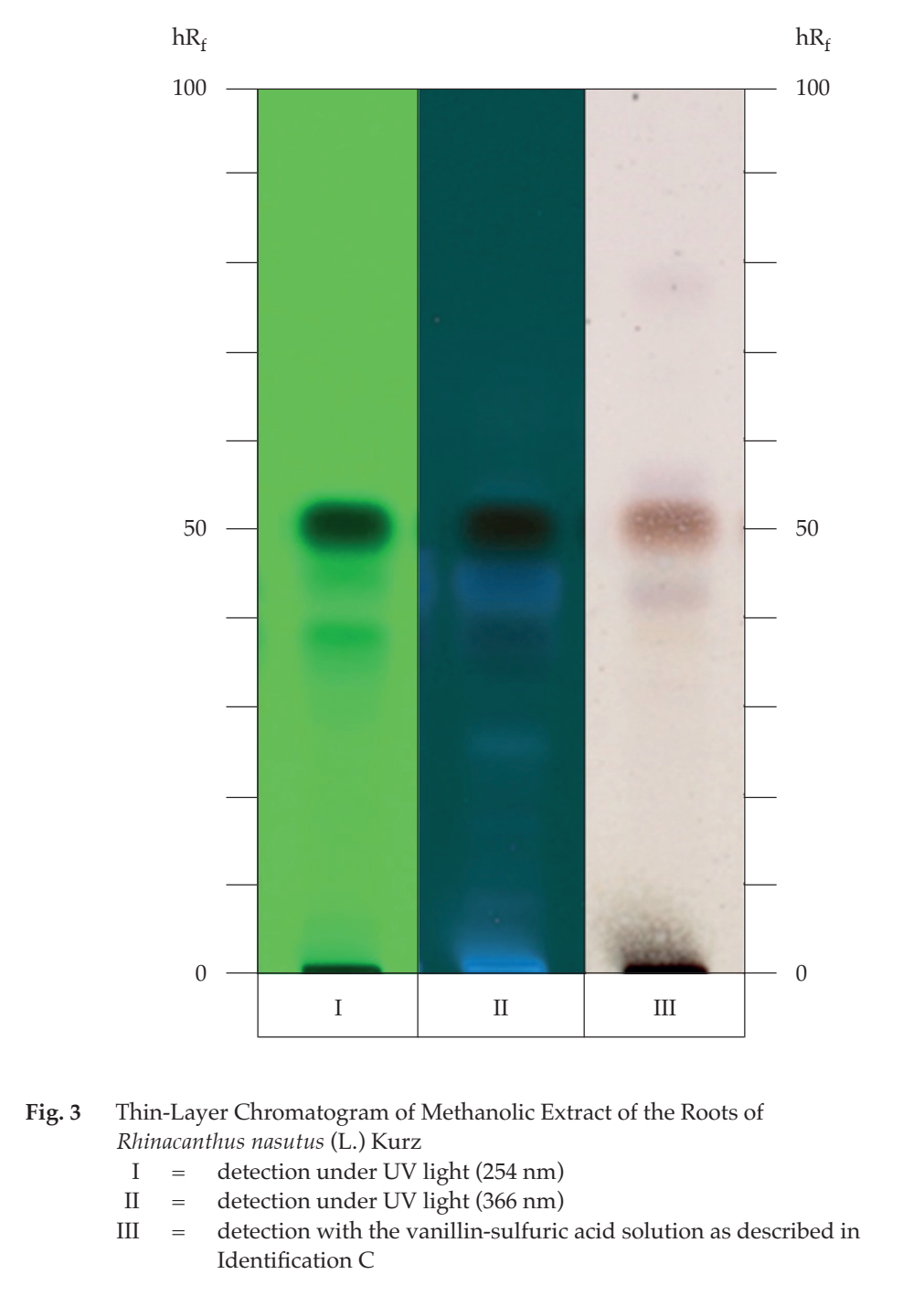ตำรามาตรฐานยาสมุนไพรไทย
Thai Herbal Pharmacopoeia
สำนักยาและวัตถุเสพติด กรมวิทยาศาสตร์การแพทย์ กระทรวงสาธารณสุข
Bureau of Drug and Narcotic, Department of Medical Sciences, Ministry of Public Health(Tinospora crispa (L.) Hook.f. & Thomson)
(Nelumbo nucifera Gaertn.)
(Centella asiatica (L.) Urb.)
(Centella Dry Extract)
(Centella Cream)
(Mesua ferrea L.)
(Piper sarmentosum Roxb.)
(Piper sarmentosum Roxb.)
(Pterocarpus santalinus L. f.)
(Santalum album L.)
(Senna tora (L.) Roxb.)
(Senna alata (L.) Roxb.)
(Senna Alata Tea)
(Piper retrofractum Vahl)
(Myristica fragrans Houtt)
(Andrographis paniculata (Burm. f.) Nees)
(Andrographis Capsules)
(Allium ascalonicum L.)
(Ocimum tenuiflorum L.)
(Curcuma longa L.)
(Turmeric Capsules)
(Turmeric Dry Extract)
(Turmeric Dry Extract Capsules)
(Arcangelisia flava (L.) Merr.)
(Curcuma sp.)
Harrisonia perforata (Blanco) Merr.
(Aristolochia pierrei Lecomte)
(Zingiber officinale Roscoe)
(Ginger Capsules)
(Ginger Tea)
(Cassia fistula L.)
(Nardostachys jatamansi (D. Don) DC.)
(Angelica sinensis (Oliv.) Diels)
Artemisia annua L.
(Ligusticum sinense Oliv. cv. Chuanxiong)
(Neopicrorhiza scrophulariiflora Pennell)
(Atractylodes lancea (Thunb.) DC.)
(Aucklandia lappa Decne)
(Terminalia chebula Retz.)
(Angelica dahurica (Hoffm.) Benth. & Hook. f. ex Franch. & Sav. var. dahurica)
(Kaempferia parviflora Wall. ex Baker)
(Hibiscus sabdariffa L.)
(Roselle Tea)
(Allium sativum L.)
(Zingiber zerumbet (L.) Sm.)
(Wurfbainia testacea (Ridl.) Škorničk.& A. D. Poulsen)
(Cannabis sativa L.)
(Myristica fragrans Houtt)
(Dracaena cochinchinensis (Lour.) S. C. Chen)
(Ficus racemosa L.)
(Hyptis suaveolens (L.) Poit.)
Clerodendrum indicum (L.) Kuntze
(Phyllanthus emblica L.)
(Citrus hystrix DC.)
(Citrus hystrix DC.)
(Areca catechu L.)
(Momordica charantia L.)
Moringa oleifera Lam.
(Aegle marmelos (L.) Corrêa)
(Solanum trilobatum L.)
(Morus alba L.)
Gynostemma pentaphyllum(Thunb.)
Makino
(Clinacanthus nutans (Burm. f.) Lindau)
(Cissus quadrangularis L.)
(Mimusops elengi L.)
(Zingiber montanum (J. König) Link. ex A. Dietr.)
(Piper betle L.)
(Capsicum annuum L.)
(Capsicum Oleoresin)
(Capsicum Gel)
(Piper nigrum L.)
(Piper nigrum L.)
(Eurycoma longifolia Jack)
(Thunbergia laurifolia Lindl.)
(Piper wallichii (Miq.) Hand.-Mazz.)
Senna garrettiana (Craib) H. S. Irwin & Barneby
(Terminalia bellirica (Gaertn.) Roxb.)
(Terminalia chebula Retz.)
(Caesalpinia bonduc (L.) H. Roxb.)
(Tarlmounia elliptica (DC.) H. Rob., S. C. Keeley, Skvaria & R. Chan)
(Hog Creeper Vine Dry Extract Capsiles)
(Hog Creeper Vine Dry Extract)
(Brachypterum scandens (Roxb.) Miq.)
(Lepidium sativum L.)
(Nigella sativa L.)
(Cuminum cyminum L.)
(Foeniculum vulgare Mill.)
(Plantago ovata Forssk.)
(Pimpinella anisum L.)
(Carum carvi L.)
(Anethum graveolens L.)
(Trachyspermum ammi (L.) Sprague)
Albizia procera (Roxb.) Benth.
(Acorus calamus L.)
(Tiliacora triandra (Colebr.) Diels)
Cyanthillium cinereum (L.) H. Rob.
(Orthosiphon aristatus (Blume) Miq.)
Murdannia loriformis (Hassk.) R. S. Rao & Kammathy
(Capparis micracantha DC.)
(Chrysopogon zizanioides (L.) Roberty)
(Cyperus rotundus L.)
(Cannabis sativa L.)
(Syzygium aromaticum (L.) Merr. & L. M. Perry)
(Boesenbergia rotunda (L.) Mansf.)
(Acanthus ebracteatus Vahl)
(Acanthus ilicifolius L.)
(Kaempferia galanga L.)
(Curcuma comosa Roxb.)
Betula alnoides Buch.-Ham. ex D. Don
Cannabis sativa L.
Carthamus tinctorius L
Mitragyna speciosa (Korth.) Havil
Mallotus repandus (Rottler) Müll. Arg
Azadirachta indica A. Juss. var. siamensis Valeton
Azadirachta indica A. Juss. var. siamensis Valeton
Punica granatum L.
Rhinacanthus nasutus (L.) Kurz
Baliospermum solanifolium (Burm.) Suresh
Curcuma aeruginosa Roxb
Boesenbergia kingii Mood & L. M. Prince
Senegalia rugata (Lam.) Britton & Rose
Acacia concinna (Willd.) DC.
Senegalia rugata (Lam.) Britton & Rose
Acacia concinna (Willd.) DC.
Senna alexandriana Mill. var. alexandriana
Cassia acutifolia Delile, Cassia angustifolia Vahl
Butea superba Roxb. ex Willd.
[Plaso superba (Roxb. ex Willd.) Kuntze, Rudolphia superba (Roxb. ex Willd.) Poir.
Pueraria candollei Graham
ex Benth. var. mirifica (Airy Shaw & Suvat.) Niyomdham
Streblus asper Lour.
Suregada multiflora (A. Juss.) Baill. (Gelonium
multiflorum A. Juss.
Snake Jasmine Root is the dried root of Rhinacanthus nasutus (L.) Kurz (Justicia nasuta L., Rhinacanthus communis Nees) (Family Acanthaceae), Herbarium Specimen Number: DMSC 5263, Crude Drug Number: DMSc 1173.
Constituents Snake Jasmine Root contains naphthoquinones (e.g., rhinacanthin A, rhinacanthin B, and rhinacanthin C). It also contains triterpenoids, flavonoids, etc.
Description of the plant (Fig. 1) Subshrub, up to 2 m tall; stem erect, stout, quadrangular, much branched, finely striated, densely pubescent when young, becoming glabrescent with age; young branch hairy. Leaves simple, opposite decussate, ovate-elliptic, elliptic to lanceolate, 6 to 12 cm long, 2 to 5 cm wide, apex acute to shortly acuminate, base cuneate or attenuate, margin entire or slightly undulate, abaxially densely pubescent, adaxially sparsely pubescent to subglabrous, secondary veins 5 or 6 pairs; petiole 1 to 1.5 cm long. Inflorescence paniculate, terminal or axillary, up to 50 cm long; rachis densely pubescent; bract lanceolate, about 2 mm long, about 0.5 mm wide; bracteole minute. Flower white to greenish white, bilabiate, sessile to subsessile; calyx 5 to 6 mm long, deeply 5-lobed, lobe lanceolate, up to 4 mm long, about 0.7 mm wide, both surfaces pubescent, outer surface with glandular trichome; corolla tube 1.5 to 2.5 cm long, upper lip upright, oblong, 8 to 9 mm long, 2 to 3 mm wide, revolute, lower lip obovate, 3-lobed, with red marking at base, 1 to 1.5 mm long, 1 to 1.3 mm wide; stamens 2, attached to apex of corolla tube, filament short, glabrous; ovary superior, elliptic, 2-loculed, each locule 2-ovuled, style slender, sparsely pubescent, stigma 2-lobed. Fruit a capsule, oblong-elliptic, 1.5 to 2 cm long, about 2 mm wide. Seeds 4, subglobose, about 2.5 mm in diameter, papillose.
Description Odour, characteristic; taste, bland to slightly bitter.
Macroscopical (Fig. 1) Cylindrical, up to 4 mm in diameter, with small lateral roots, greyish brown; surface with longitudinal wrinkles.
Microscopical (Figs. 2a, 2b, 2c) Transverse section of primary growth of the root shows epidermis, cortex, vascular tissue, and pith. Epidermis: 1 to 2 layers of polygonal cells with greenish brown cell wall. Cortex: numerous round parenchyma, some containing cystoliths or microcrystals; red liquid substance in intercellular space of parenchyma; and 1 to 2 layers of endodermis. Vascular tissue: 1 to 2 pericycle layers; vascular bundle, alternate; and 5 arches of xylem tissues and phloem tissues. Pith: thin-walled round parenchyma.
Transverse section of secondary growth of the root illustrates periderm, cortex, and vascular tissue. Periderm: numerous layers of rectangular cork cells. Cortex: numerous round parenchyma; lithocyst, oblong parenchyma, some containing microcrystals; red liquid substance in intercellular space; and crushed brown layers of endodermis cells. Vascular tissue: secondary phloem comprising parenchyma and groups of sclereids; secondary xylem consisting of vessels, xylem ray and xylem fibres; and primary vascular tissue in the centre.
Snake Jasmine Root in powder possesses the diagnostic microscopical characters of the unground drug. Lithocysts, cystoliths, and reddish substance are characteristic.
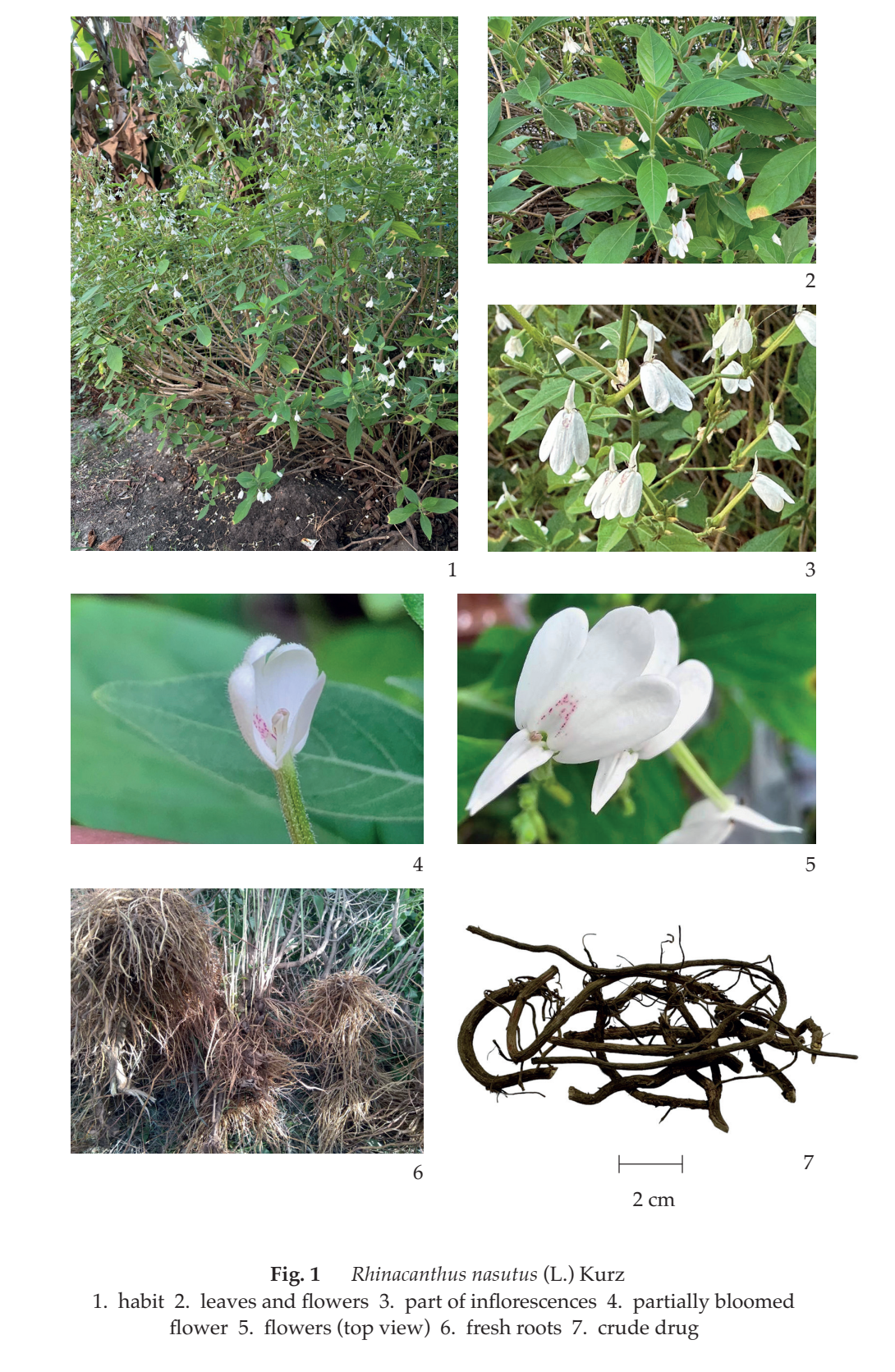
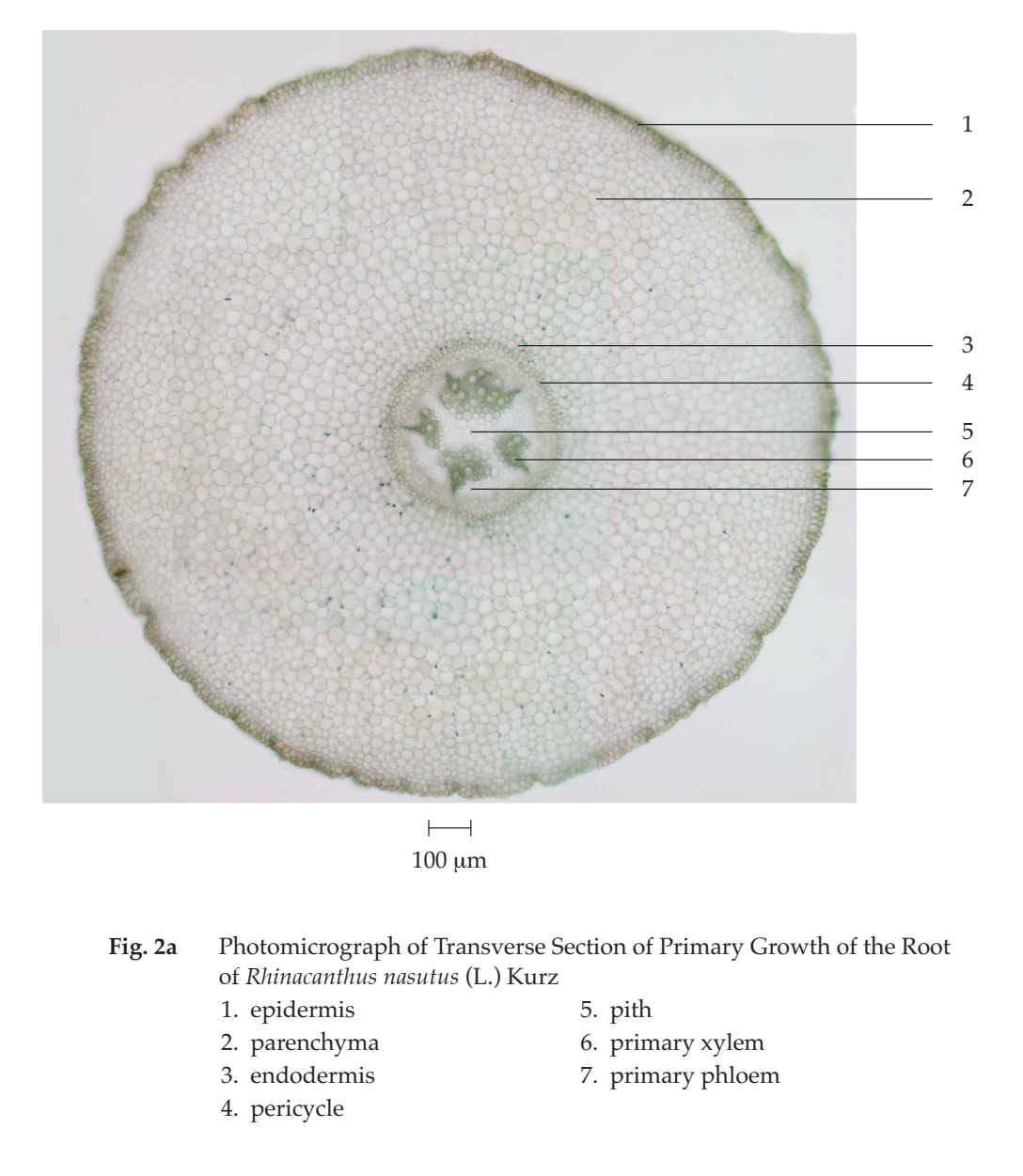

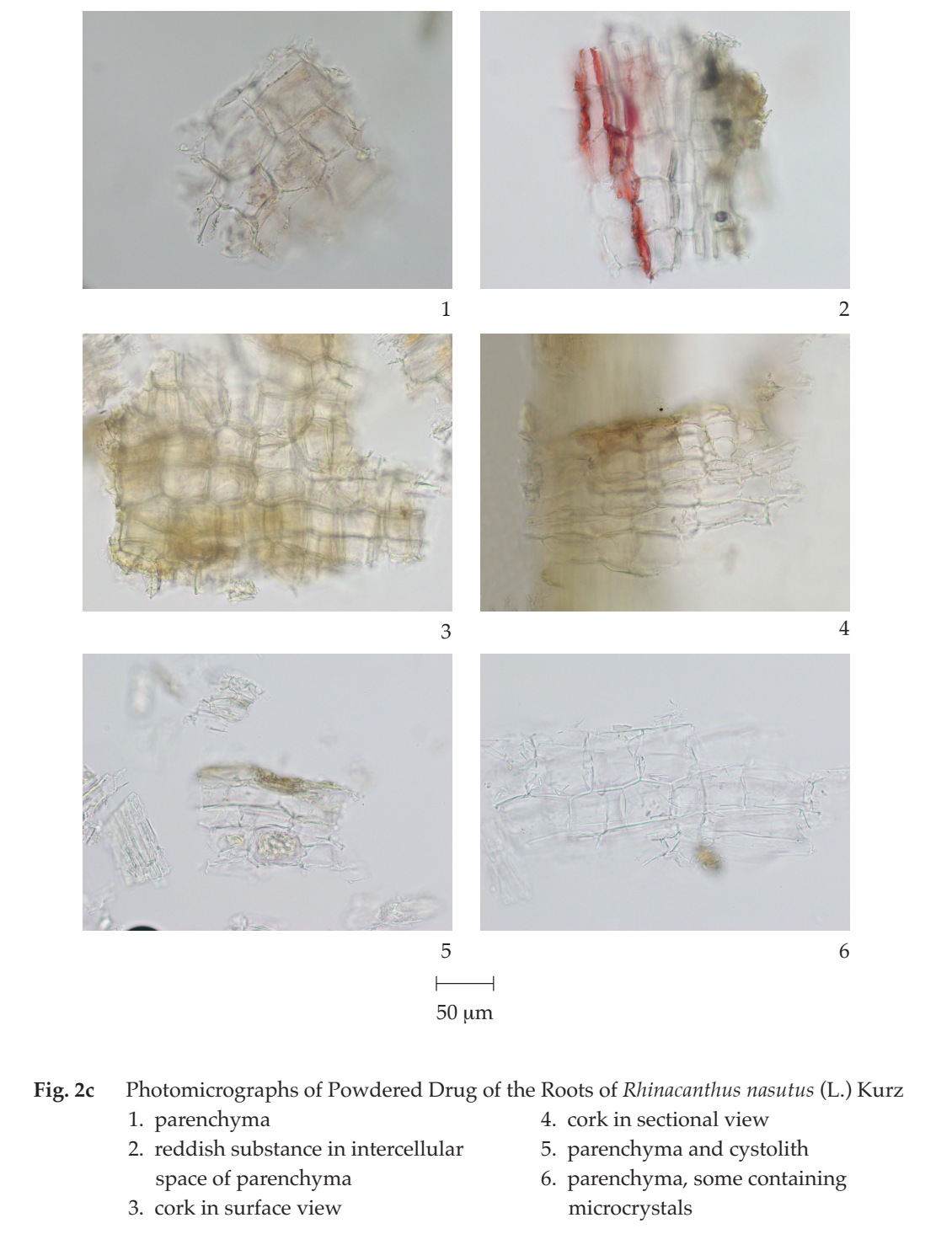
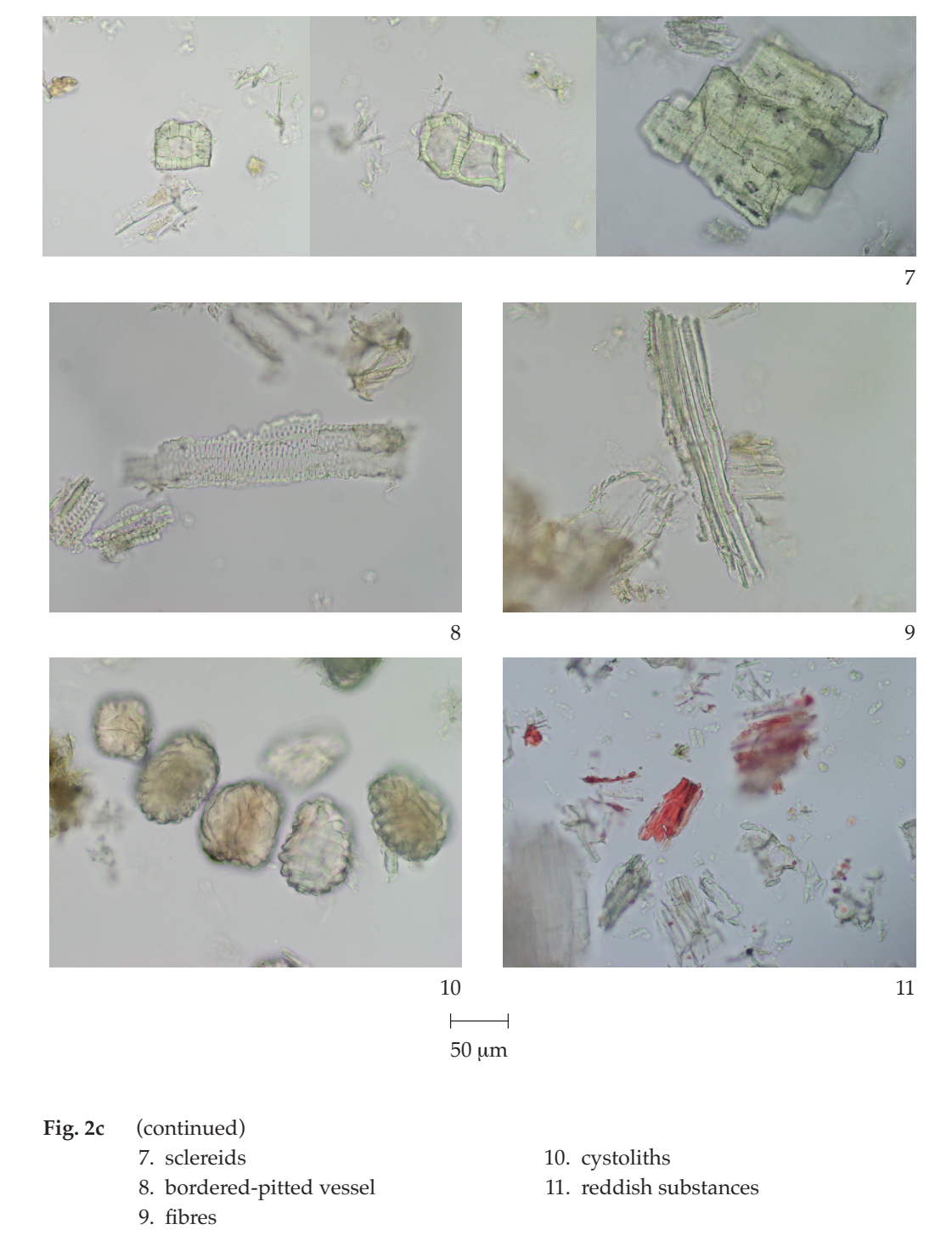
Packaging and storage Snake Jasmine Root shall be kept in well-closed containers, protected from light, and stored in a dry place.
Identification
A. To 1 g of the sample, in powder, add 20 mL of chloroform, heat in a water-bath for 5 minutes, and filter immediately, and allow to cool (solution 1): a reddish solution is obtained.
B. To 10 mL of solution 1, add 10 mL of ammonia TS and shake: the aqueous layer becomes pale orange-brown.
C. Carry out the test as described in the “Thin-Layer Chromatography” (Appendix 3.1), using silica gel G F254 as the coating substance and a mixture of 70 volumes of hexane and 30 volumes of ethyl acetate as the mobile phase and allowing the solvent front to ascend 8 cm above the line of application. Apply to the plate as a band of 8 mm, 20 µL of the test solution, prepared by sonicating 100 mg of the sample, in fine powder, with 2 mL of methanol for 10 minutes and filtering. After removal of the plate, allow it to dry in air and examine the plate under ultraviolet light (254 nm), marking the quenching bands. Examine the plate under ultraviolet light (366 nm) through the cut-off filter; one brown and three blue fluorescent bands are observed. Subsequently spray the plate with the solution prepared by dissolving 500 mg of vanillin in 40 mL of sulfuric acid, adding 10 mL of ethanol, and mixing. Then heat at 105° for 10 minutes. Two brown and three purple bands are observed (Fig. 3).
Loss on drying Not more than 9.0 per cent w/w after drying at 105° to constant weight (Appendix 4.15).
Foreign matter Not more than 2.0 per cent w/w (Appendix 7.2).
Acid-insoluble ash Not more than 2.0 per cent w/w (Appendix 7.6).
Total ash Not more than 16.0 per cent w/w (Appendix 7.7).
Ethanol-soluble extractive Not less than 7.0 per cent w/w (Appendix 7.12).
Water-soluble extractive Not less than 35.0 per cent w/w (Appendix 7.12).
